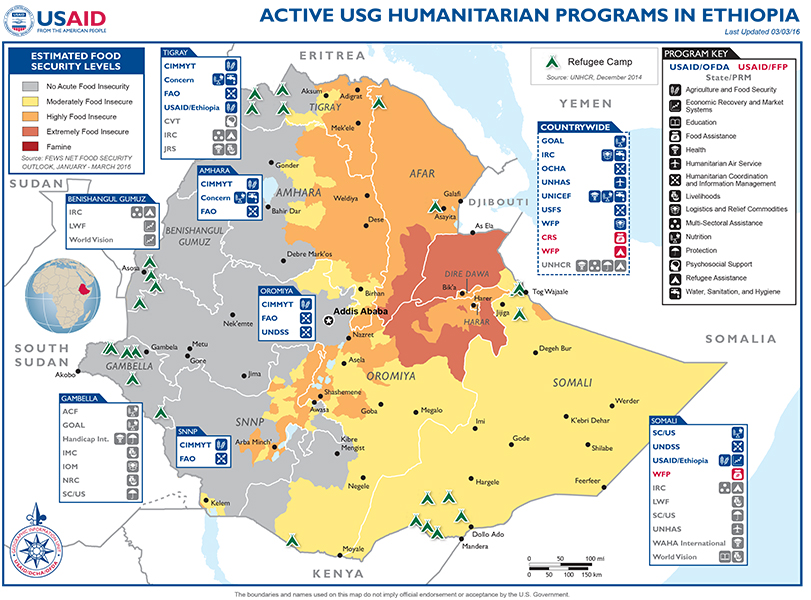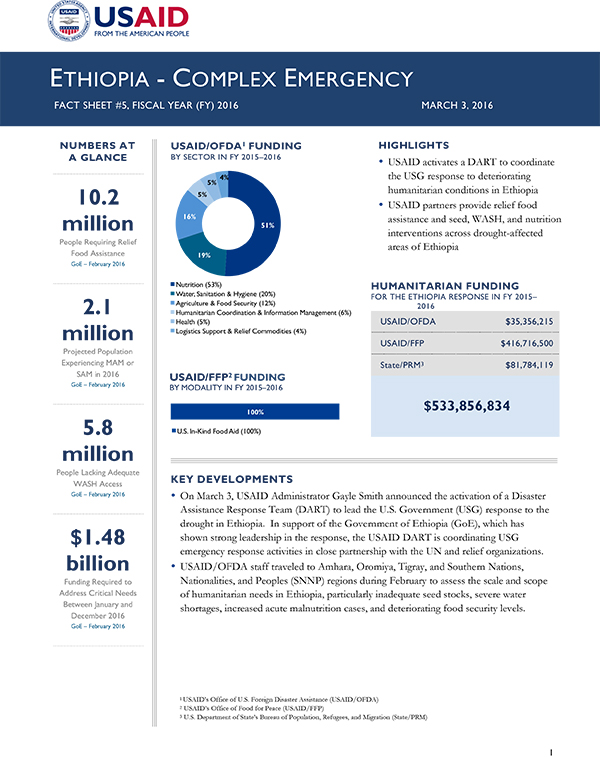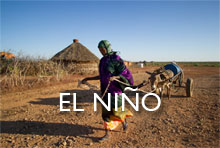- What We Do
- Agriculture and Food Security
- Democracy, Human Rights and Governance
- Economic Growth and Trade
- Education
- Ending Extreme Poverty
- Environment and Global Climate Change
- Gender Equality and Women's Empowerment
- Global Health
- Water and Sanitation
- Working in Crises and Conflict
- Disaster Assistance
- Political Transition Initiatives
- Conflict Mitigation and Prevention
- Countering Violent Extremism
- Disaster Risk Reduction
- Peacebuilding and Reconciliation
- Providing Safe & Secure Environments for Development
- Recovering From Crisis
- Resilience
- Tech Challenge for Atrocity Prevention
- World Humanitarian Day
- U.S. Global Development Lab
March 3, 2016
Highlights
USAID activates a DART to coordinate the USG response to deteriorating humanitarian conditions in Ethiopia
USAID partners provide relief food assistance and seed, WASH, and nutrition interventions across drought-affected areas of Ethiopia
Key Developments
Ethiopia Map - 03-03-2016 ![]() (pdf - 788k)
(pdf - 788k)
Numbers At A Glance
10.2 million
2.1 million
5.8 million
$1.48 billion
Humanitarian Funding
For the Ethiopia Response
FY 2015 - 2016
| USAID/OFDA | $35,356,215 |
| USAID/FFP | $416,716,500 |
| State/PRM | $81,784,119 |
| TOTAL | $533,856,834 |
On March 3, USAID Administrator Gayle Smith announced the activation of a Disaster Assistance Response Team (DART) to lead the U.S. Government (USG) response to the drought in Ethiopia. In support of the Government of Ethiopia (GoE), which has shown strong leadership in the response, the USAID DART is coordinating USG emergency response activities in close partnership with the UN and relief organizations.
USAID/OFDA staff traveled to Amhara, Oromiya, Tigray, and Southern Nations, Nationalities, and Peoples (SNNP) regions during February to assess the scale and scope of humanitarian needs in Ethiopia, particularly inadequate seed stocks, severe water shortages, increased acute malnutrition cases, and deteriorating food security levels.
CURRENT EVENTS
On March 3, USAID Administrator Smith announced the activation of a DART to lead the USG crisis response to the drought in Ethiopia. The USAID DART is coordinating USG activities in response to the drought emergency and deploying additional staff to Ethiopia with specialized expertise in the agriculture, livestock, and nutrition sectors, as well as other technical and humanitarian response experts. The USAID DART is also framing an integrated strategy to guide the whole-of-government response effort, building on existing resilience platforms and the USAID response to date—the USG began responding early to the impacts of the drought in mid-2015 through crisis modifiers to existing development programs when early warnings projected a decreasing food security situation. USAID will continue to provide emergency food assistance; nutrition and health support; and water, sanitation, and hygiene (WASH) interventions to drought-affected populations across Ethiopia. USAID has also established an Ethiopia Drought Response Management Team (RMT) based in Washington, D.C., to support emergency response efforts.
On February 21, USAID hosted a roundtable in Ethiopia’s capital city of Addis Ababa that included USAID Administrator Smith; U.S. Ambassador to Ethiopia Patricia M. Haslach; U.S. Senators Mike Enzi, Jim Inhofe, and Mike Rounds; U.S. Congressmen Randy Hultgren, Reid Ribble, and Tim Walberg; USAID/OFDA and USAID/FFP representatives; and USAID partners Catholic Relief Services (CRS), Concern, and Mercy Corps. The discussion focused on the drought in Ethiopia and the effects of the El Niño climatic event in eastern and southern Africa.
During the event, Administrator Smith emphasized that the USG has an opportunity to help limit the worst effects of the drought in Ethiopia. The Administrator also noted that the USG has invested significant resources to build resilience and reduce drought effects across the country. The humanitarian needs generated by the current drought, however, exceed the resilience capacity of affected Ethiopians. Given widespread humanitarian needs, Administrator Smith called for increased international donor funding to protect development gains and prevent further deterioration of the humanitarian situation. The GoE is leading response efforts and has contributed approximately $381 million to support the drought response, while the USG remains the largest international donor to Ethiopia, providing nearly $534 million in emergency assistance since October 2014.
As of mid-February, the GoE and international donors had provided approximately 48 percent toward the more than $1.4 billion requested in the 2016 Humanitarian Requirements Document (HRD), which outlines anticipated humanitarian needs in Ethiopia between January and December 2016, according to the UN. Relief actors report needing substantial lead time—up to four months or more—for procuring and transporting essential relief supplies to Ethiopia, including food assistance. In response, the UN has urged international donors to mobilize additional resources immediately to ensure continued humanitarian assistance through the July-to-September period, when humanitarian needs are expected to peak.
Emphasizing the need for timely support, the UN has called for $228 million in prompt funding to prevent breaks in relief food assistance pipelines; $22 million to treat people experiencing moderate acute malnutrition (MAM) and severe acute malnutrition (SAM); $15 million to procure seeds and fertilizer for more than 5.6 million drought-affected farmers by the end of March; and $3 million to deliver safe drinking water and prevent large-scale population migrations. In response to funding gaps, the GoE and the Humanitarian Country Team for Ethiopia—comprising representatives from the UN, international organizations, donors, and non-governmental organizations (NGOs)—are developing a joint fundraising campaign to meet increased needs, protect livelihoods, and safeguard Ethiopia’s development gains.
AGRICULTURE AND FOOD SECURITY
The GoE and the UN Food and Agriculture Organization (FAO) estimate that approximately 900,000 households require emergency seed support across Ethiopia. Failure to provide sufficient seeds for planting in May/June could limit late-2016 harvests, compromising the drought recovery in 2017 even if rainfall is adequate during 2016. The immediate procurement and distribution of seeds is required to protect household assets and livelihoods, prevent further drought-related displacement, and avoid increased emergency food assistance needs.
To support emergency seed interventions across Ethiopia, USAID has already authorized the International Maize and Wheat Improvement Center (CIMMYT) to use existing USAID funding for immediate emergency maize and wheat seed support to drought-affected households for the January-to-March belg planting season in Amhara, Oromiya, SNNP, and Tigray regions. In addition, USAID—in coordination with USAID/OFDA and the USG’s Feed the Future initiative—and the Bill & Melinda Gates Foundation are supporting emergency seed interventions in 67 drought-affected woredas, or districts. As part of this collaborative effort, the USG is providing more than $3.9 million and the Bill & Melinda Gates Foundation is providing $1.5 million to CIMMYT and Ethiopia’s Agricultural Transformation Agency to deliver high-quality, drought-tolerant maize and disease-resistant wheat seed to approximately 226,000 households, or more than 1.3 million people, for the upcoming meher planting season.
From February 14–19, USAID/OFDA and USAID/FFP market advisors conducted a joint assessment of food security and the market situation in Ethiopia, meeting with USAID/Ethiopia staff, GoE representatives, international donors, and humanitarian partners. Given the large-scale humanitarian crisis in Ethiopia, the USAID advisors recommended that relief organizations select food assistance modalities—cash or in-kind food assistance—based on current and prospective market conditions.
The USAID/FFP-supported, CRS-led Joint Emergency Operation (JEOP) is providing relief food assistance for 2.6 million people in Amhara, Oromiya, SNNP, Somali, and Tigray regions. To date in FY 2016, USAID/FFP has provided nearly $207 million in emergency food assistance via JEOP to support food assistance distributions through July 2016. In addition, USAID/FFP has provided more than $42 million in relief food assistance—62,520 metric tons (MT)—to support UN World Food Program (WFP) relief operations in Ethiopia.
NUTRITION AND WASH
During the week of January 25, USAID/OFDA staff traveled to Amhara and Tigray to meet with USAID/OFDA partners, including NGOs Concern and GOAL, and to observe emergency response interventions. With support from USAID/OFDA, Concern and GOAL deliver nutrition response interventions for drought-affected populations in the regions. While in Tigray’s Hintalo Wajirat district, USAID/OFDA staff visited a GOAL-supported stabilization center and outpatient therapeutic feeding program.
Health care workers in the district reported more than 9,000 cases of scabies in recent months, in addition to children experiencing acute malnutrition. Community members reported that a lack of safe drinking water has resulted in increased incidence of diarrheal diseases, exacerbating acute malnutrition. In addition, many water sources, including wells, are dry due to the drought, forcing some community members to drink unsafe water from open sources, such as ponds.
As a partner of a USAID/OFDA-funded, GOAL-managed countrywide nutrition rapid response platform, Mercy Corps is implementing emergency nutrition interventions, including treatment of MAM and SAM cases, in Afar Region’s Zone 3 and Zone 4. As part of the response, Mercy Corps is working through the public health system, bolstering local health care staff capacity and utilizing a community-based management of malnutrition strategy—a methodology for treating acute malnutrition among children using an active case-finding and triage approach. Between October 2015 and early February 2016, Mercy Corps treated more than 2,400 MAM cases and 590 SAM cases in Afar, while also providing medical treatment to more than 40 individuals experiencing medical complications associated with SAM. During the same period, Mercy Corps staff helped provide nutrition training to nearly 40 health care workers, more than 30 health extension workers, and 250 community volunteers.
USAID/OFDA recently provided nearly $2.7 million to Save the Children/U.S. (SC/US) to support life-saving nutrition, WASH, and emergency feed and fodder interventions for more than 130,000 people in drought-affected areas of Somali.
LOGISTICS
The GoE, USAID, and relief organizations continue to address congestion and other logistical challenges at the Port of Djibouti—the primary port handling shipments of emergency relief commodities destined for Ethiopia. WFP is utilizing other regional ports, including the Port of Berbera in northwestern Somalia, to expedite transportation of emergency food assistance to Ethiopia. As of mid-February, WFP had transported approximately 40,000 MT of food commodities through Berbera, most of which supported populations in Ethiopia’s Somali Region—one of the most drought-affected areas of the country.
USG logistics specialists are evaluating challenges at the Port of Djibouti and plan to provide further analysis in the coming weeks regarding how USAID can alleviate ongoing logistics and transportation constraints.
POPULATION DISPLACEMENT
The International Organization for Migration (IOM) reported more than 30,000 newly displaced people in Ethiopia during January, representing a 55 percent decrease from the more than 67,000 newly displaced individuals identified in December 2015. IOM recorded population displacement in three regions—Oromiya, SNNP, and Somali—and found that conflict generated the majority of the new displacement, with only 6,200 individuals from Somali’s Sitti Zone reportedly displaced due to drought. Between August 2015 and January 2016, the effects of the drought have reportedly displaced approximately 260,000 individuals from Afar, Oromiya, and Somali; however, more than 80,000 displaced people had returned to areas of origin by the end of January, according to IOM. Seasonal displacement is common in Ethiopia, even absent drought conditions, and determining migration figures—including atypical droughtinduced migration—remains challenging.
HUMANITARIAN ASSESSMENTS
During the week of February 15, staff from USAID/OFDA traveled to SNNP to assess humanitarian needs and monitor the ongoing drought response, particularly nutrition interventions and relief food assistance. USAID/OFDA partner GOAL is currently providing emergency treatment of acute malnutrition in five SNNP zones—Gamo Gofa, Gedio, Hadiya, Kembata Tembaro, and Silti. Since December 2015, GOAL has observed a moderate decrease in acute malnutrition cases due to deliveries of relief food assistance, cash or food assistance under the GoE-managed Productive Safety Net Program, and availability of belg root crop harvested in lowland areas. Despite the seasonal decline, GOAL anticipates that acute malnutrition cases will increase during 2016 due to the drought. In response, GOAL is expanding nutrition interventions in SNNP and delivering emergency seeds with support from the UNmanaged Humanitarian Response Fund (HRF).
From February 15–17, USAID/OFDA and Concern staff visited Amhara’s Debak, Janamora, and Wogera districts in North Gondar Zone to monitor community-based management of acute malnutrition programs and assess impacts of the drought. In response to deteriorating food security, households in North Gondar reported using negative coping strategies, such as selling livestock below market prices, migrating for labor, and accruing additional debt. In addition, the majority of health care centers in the zone lack access to safe drinking water, with health care staff retrieving water from open sources, such as streams and rivers. In rural areas, women and children are reportedly walking up to six hours to retrieve safe drinking water. To improve access to safe drinking water, local GoE officials have purchased donkeys for schools and health care centers in remote locations to assist in transportation. Local GoE officials also lauded USAID/OFDA partner Concern’s relief operations in Amhara, noting that the organization’s efforts have improved treatment of acute malnutrition in the region. Concern is also providing technical assistance, building local response capacity, delivering emergency relief supplies, and bolstering logistics infrastructure.
During the week of February 7, USAID/OFDA staff traveled to Oromiya’s East Hararghe Zone to assess the drought conditions—particularly the impact on livestock, nutrition, and seed availability—and monitor response programs’ ability to mitigate the impact of these conditions. Local authorities reported that the 2015 rains failed in much of East Hararghe, and preliminary assessments of the 2015/2016 October-to-January meher harvest found that only approximately 20 percent of planted seeds produced a crop in the zone. Farmers in East Hararghe require significant seed support for the upcoming planting seasons due to poor harvests. CRS, with HRF funding, is procuring and distributing seed to farmers for the belg planting season in nine districts of East Hararghe and West Hararghe zones.
A CRS partner reported that relief food assistance and other humanitarian interventions in East Hararghe had prevented large-scale population movement and drought-related migration. Commenting on the effects of the drought, local authorities in East Hararghe’s Fedis District reported that the 2015 June-to-August belg harvest produced crops only suitable for livestock consumption, while the 2015 meher harvest failed to produce any usable crops. The local community had not reported significant livestock deaths as of mid-February 2016, in part because the GoE has supported the community with animal feed from other areas of Ethiopia.
CONTEXT
Multiple consecutive seasons of below-normal rainfall—exacerbated by the effects of the El Niño climatic event—have resulted in deteriorating agricultural, livestock, food security, and nutrition conditions in northeastern and central Ethiopia. By February 2016, the GoE estimated that 10.2 million people required relief food assistance and other humanitarian interventions.
USAID activated a DART on February 24, 2016, to lead the USG crisis response to the drought in Ethiopia. Under the strong leadership of the GoE, the DART is coordinating USG response activities in close partnership with the UN and other relief organizations. The DART—composed of humanitarian specialists based in Ethiopia—is addressing critical needs and examining ways to realign activities to respond to urgent assistance gaps. USAID also established an Ethiopia Drought RMT based in Washington, D.C., to support emergency response efforts in Ethiopia.
While drought remains a major contributor to vulnerability in Ethiopia, negatively affecting the lives and livelihoods of farmers and pastoralists, populations also continue to confront other challenges—including seasonal flooding, localized intercommunal conflict, above-average food prices, disease outbreaks, and limited access to health and WASH services—that contribute to sustained humanitarian needs and an ongoing complex emergency in Ethiopia.
On October 7, 2015, U.S. Chargé d’Affaires, a.i., Peter H. Vrooman redeclared a disaster for Ethiopia in response to the ongoing complex emergency.
PUBLIC DONATION INFORMATION
The most effective way people can assist relief efforts is by making cash contributions to humanitarian organizations that are conducting relief operations. A list of humanitarian organizations that are accepting cash donations for disaster responses around the world can be found at www.interaction.org.
USAID encourages cash donations because they allow aid professionals to procure the exact items needed (often in the affected region); reduce the burden on scarce resources (such as transportation routes, staff time, and warehouse space); can be transferred very quickly and without transportation costs; support the economy of the disaster-stricken region; and ensure culturally, dietary, and environmentally appropriate assistance.
More information can be found at:
- USAID Center for International Disaster Information: www.cidi.org or +1.202.821.1999.
- Information on relief activities of the humanitarian community can be found at www.reliefweb.int.










Comment
Make a general inquiry or suggest an improvement.